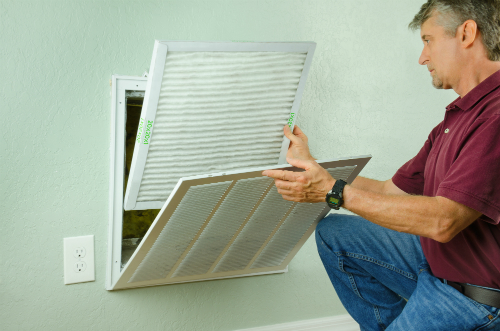Welcome to the Take Charge of Your Home series from Direct Energy! Hiring a professional to perform household maintenance may offer convenience and peace of mind, but you can do many of these jobs yourself with no experience or special tools. And in the process, you’ll save money, learn about how your home works and gain a sense of accomplishment from a DIY task done well!
The whole point of climate control technology is to help you feel comfortable. But in some circumstances, it can be a big headache -- literally.
HVAC systems can lead to headaches or even migraines in a variety of circumstances. In the most dire scenario, a headache can be a lifesaving early warning sign of a carbon monoxide leak. Fortunately, most HVAC-related headaches are caused by less serious issues that can be remedied with changes in habits or equipment.
How Your AC Can Cause Dehydration & Headaches
You already know that an air conditioner’s job is to cool down the air, but you might not know that it simultaneously serves as a dehumidifier. This is a critical function, because a home that is cool yet humid will feel clammy and provide a breeding ground for mold and mildew. That will create foul odors and eventually produce a health hazard.
Sometimes an air conditioner can pull so much moisture out of the air that it puts inhabitants of the space at slightly increased risk of dehydration. When the air around you is dry, it actually draws moisture out of your body faster, forcing you to drink more water than usual to remain hydrated. If you fall behind and become dehydrated, headaches are among the most common symptoms.
Excessive dehumidifying is sometimes a problem in environments like office buildings, where the people inside might not have control over the thermostat, and hotel rooms, where there may be a powerful air conditioner in a small, otherwise unventilated space.
Dehydration isn’t just a summertime problem; dry indoor air is a common problem in winter, as well. But during cold weather months, it’s not the furnace over-drying the air in your home -- it’s drafts. Air leaking through cracks and around doors and windows let the dry winter air flow right in, and if you have leaky ductwork, the air may dry out even more.
How to Tell if Your Home Air is Too Dry
If you suspect an indoor environment is too dry, there’s an easy way to know for sure. Pick up an inexpensive digital hygrometer, which is a device that measures relative humidity. If you have an indoor digital thermometer, it may have a hygrometer as a built-in feature. Ideal indoor humidity is between 40 and 50 percent, and anything lower than 30 percent suggests greater potential for dehydration headaches.
So what can you do about it? The easiest thing is to drink plenty of water. Whenever you start to feel any combination of the most common dehydration symptoms -- headache, extreme thirst, dry eyes, dry skin, nausea and muscle cramps -- make an effort to hydrate. Sports drinks with electrolytes also aid in replenishing those fluids.
If you have control over the thermostat, try setting it a few degrees higher in summer so that the air conditioning doesn’t run so frequently. You can also temporarily switch the fan setting from “auto” to “on”, which can bring in humid outdoor air between cooling cycles. If you’re in an office environment where you don’t control the thermostat, you can set up a small humidifier in the area where you spend most of the day.
Why Indoor Air Quality (IAQ) is Important HVAC stands for heating, ventilation and air conditioning, but there’s another dimension of modern HVAC systems that isn’t mentioned: indoor air quality. Often called “IAQ” among HVAC professionals, indoor air quality refers to how safe and healthy a structure’s air is for people to breathe.
There are all sorts of pollutants that can adversely affect the IAQ in your home, most of which originate indoors rather than seeping in from outside. Things like aerosol sprays, tobacco products and pet dander all bring down the quality of the air, as can certain building materials like asbestos insulation and pressed wood.
Outdoor pollution can infiltrate the home as well, both by flowing in through cracks and being cycled in by the HVAC system. In areas with high levels of smog, chemical pollution or other types of chronic air quality issues, this may be the primary challenge to improving IAQ.
All of these sources can contribute to headaches and a range of other symptoms, especially among people who suffer from allergies, asthma and other respiratory conditions. Dizziness, shortness of breath and irritation of the eyes, nose and throat are other common problems that can be caused by poor IAQ.
There are filters in every HVAC system, and they play an important part in controlling indoor pollutants, but most filters only capture the largest airborne particles. For some of the most problematic IAQ issues, like controlling chemical pollution, HVAC systems should be upgraded with special equipment.
In homes where the biggest irritants are particles like dust and pet dander, the solution may be to install a standalone air filtration system. These complement the air filtering abilities of HVAC systems using specialized filters capable of catching smaller particles. Another solution is to replace disposable filters with electrostatic filters that trap more particles by attracting them with an electric charge.
Another type of IAQ technology cleans the air using light. Ultraviolet light air purifiers control irritating gases, odors, germs and viruses by emitting ultraviolet light inside a home’s air ducts. This can neutralize IAQ problems that might slip past a high-quality filtration system, so the most effective approach is often to use both technologies in tandem.
The Dangers of Carbon Monoxide Exposure
The most serious type of HVAC-related headache is caused by carbon monoxide exposure. As a result of improper installation or rare malfunctions, furnaces can release carbon monoxide into homes and buildings. As an odorless, tasteless gas, carbon monoxide can overcome a person without warning, causing a deadly drop in blood oxygen.
Headache, dizziness and nausea are the primary early symptoms of carbon monoxide poisoning. These progress to disorientation, drowsiness, blurred vision, seizures and eventually death. If you ever suspect you’re suffering from carbon monoxide poisoning, leave the area immediately, warn others and call 911.
This tragedy can be avoided through prevention and detection. Make sure all HVAC equipment is installed by a trained, licensed technician and maintained annually. During your annual furnace inspection, verify that the heat exchanger is in good condition -- this is the part that vents deadly gas outside the home.
As a failsafe, install carbon monoxide detectors on every floor of your home and in every bedroom. Like smoke detectors, these devices monitor continuously for deadly increases in carbon monoxide and make safe escape possible.
Ask Your Doctor Even if you suspect your headaches are related to the HVAC system at home or work, there’s no substitute for talking about the problem with your physician. A doctor may recommend tests or changes in habits that could point to a completely different cause.
But there are many benefits to making sure your indoor air is not too dry, not too dirty and free from dangerous carbon monoxide levels. Keeping headaches at bay is just one of them. If you’re ready to take steps toward a cleaner, safer HVAC system, call an expert technician for more information.

